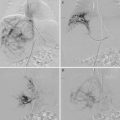© Springer-Verlag Italia 2015
Raul Mattassi, Dirk A. Loose and Massimo Vaghi (eds.)Hemangiomas and Vascular Malformations10.1007/978-88-470-5673-2_2020. Epidemiology of Vascular Malformations
(1)
Division of Vascular Surgery, Department of Surgery, George Washington University Medical Center, Washington, DC, USA
(2)
Division of Vascular Surgery, Cardiac and Vascular Center, Samsung Medical Center, Sungkyunkwan University School of Medicine, Seoul, Korea
(3)
Department of Radiology, SamSung Medical Center, Sungkyunkwan University School of Medicine, Seoul, Republic of Korea
Keywords
Epidemiological datacongenital vascular malformationIncidence and prevalenceHamburg classificationISSVA classificationIncidence and Prevalence
Congenital vascular malformation (CVM) has been a symbol of confusion among various vascular disorders through decades, and naturally its epidemiological data as well were based on much confusing definition and classification of the CVMs [1–3].
Despite a new era of the CVMs based on the contemporary concept of the Hamburg Classification [4–6] that has taken over the old era of “angiodysplasia” with mostly name-based eponyms/classifications through the last three decades, a substantial confusion remained misguiding clinical interpretation of the CVMs including their epidemiologic data as well.
For example, the term “hemangioma” is still mistakenly used for the extratruncular type of venous malformation (VM) despite a genuine hemangioma that is NOT a vascular malformation but a vascular tumor [7–9]. Hence, many of the VMs were misrepresented as a hemangioma and classified erroneously in hospital records, publications, etc. Besides, the majority of “mixed” conditions of various CVMs were recorded separately from other CVMs as one of numerous syndrome-based vascular disorders.
Therefore, the epidemiologic data available in the literatures in the mid of this confusing era often misguide true incidence and prevalence of the CVMs altogether with the confusing definition of new and old terminology, and the overall dependability of the data for its incidence and prevalence is quite limited.
Nevertheless, Stevenson AC et al. reported an overall frequency of major and minor malformations of 12.7 % in single births and 4.6 % in multiple births in a large-scale study sponsored by the World Health Organization in 1977 based on the survey of 426,932 live and stillborn births [10].
Similarly, Myrianthopoulos NC [11] reported the epidemiological characteristics of CVM occurring in 53,394 consecutive single births and in 1,197 twin births in a prospective Collaborative Perinatal Project based on the information recorded according to preestablished uniform guidelines; at the end of the first year of life, malformations were detected in 15.6 % of singletons. Multiple malformations were diagnosed in 2.6 % of the single offspring; the highest frequency was associated with the cardiovascular system (74.4 %).
Kennedy WP et al. also reported the overall incidence of CVM as 1.08 % ranging from 0.83 to 4.5 % based on comprehensive review of 238 studies on the world literature reporting more than 20 million births [12]. These overall incidences of CVM were obtained from hospital records, birth certificates, and also retrospective questionnaires from intensive examinations of children. However, this study highlighted the variability in reporting methods due to differences in terminology and inconsistent diagnostic criteria.
These landmark studies, however, represent the era of marked misconceptions on the CVMs with confusing nomenclature before great advances were made in the understanding of the pathophysiology, classification, nomenclature, and treatment of all vascular lesions through the past three decades.
A new concept is now established for the CVMs (e.g., Hamburg Classification) with appropriate differentiation with often confusing vascular tumor represented by the hemangioma (e.g., ISSVA Classification). The CVMs solely represent the group of various birth defects affecting the vascular system(s); over 90 % present at birth with a male–female ratio of 1:1 [13–15].
Depending upon the vascular system(s) affected and also the embryological stage when the developmental arrest has occurred, the CVMs present strikingly different characteristics from each other with a much different clinical condition morphologically, pathophysiologically, and also hemodynamically (e.g., extratruncular and truncular lesions) [16–18].
Within this boundary of new concept, further reliable epidemiological data became available through the last decade; Tasnadi G et al. (1993) reported overall incidence of the CVM in 1.2 % (43 out of 3,573) based on a study carried on 3,573 3-year-old children: infiltrating or localized venous malformation (VM) and/or arteriovenous malformation (AVM) in 16 cases (37 %), capillary malformation (CM)/port-wine stain in 15 cases (35 %), lymphatic malformation (LM)/primary lymphedema in 5 cases (12 %), phlebectasia with nevus and limb length discrepancy in 5 cases (12 %), and phlebectasia in 2 cases (4 %) [19].
Eifert S and Villavicencio JL et al. also reported (2000) the prevalence of deep venous anomalies among the VMs, diagnosed with modern technology: duplex scanning, plethysmography, computerized tomography, magnetic resonance imaging, and angiography. Among 392 patients with various CVMs, 257 (65.5 %) were confirmed as VM of deep venous anomalies in various conditions of phlebectasia, aplasia or hypoplasia of venous trunks, aneurysms, and avalvulia [20]. Phlebectasia was the most frequent (36 %), followed by aplasia or hypoplasia of the deep venous trunks (8 %) and venous aneurysms (8 %). At least one deep venous anomaly was present in 47 % of the patients with predominantly VMs.
Although most of the published data on the CVMs by referral centers suggest that the VM is the most common CVMs, they are estimated to occur in 1 in 5,000–10,000 childbirths [21].
But, the CM with clinical manifestation as port-wine stain of the skin and mucosa is still much more common than the VM, occurring in 0.3 % of childbirths [22].
Besides, the VMs [23–25] are certainly the most frequent type of the CVMs to need a medical attention since the AVMs [26–28] are relatively rare, and much less visible LMs [29–31], especially the truncular type known as a primary lymphedema, are often neglected as one of the CVMs.
Lee BB et al. reported that the LMs are as common as the VMs among a total of 797 CVM cases (315/797) (1995–2001: 446 females and 351 males; mean age 22.1 years in the range of 14 days to 81 years), when both extratruncular LM/lymphangioma and truncular LM/primary lymphedema are counted together: LM 315 (39.5 %), VM 294 (36.9 %), AVM 76 (9.5 %), and combined CVMs/hemolymphatic malformation (HLM) 66 (8.3 %), although unclassified CVMs − 40 (5.0 %) – that are mostly VM to be confirmed later were not counted [32].
Lee BB et al. made further extended review on the predilection site of the CVMs among a total of 1,203 patients (1994–2003), which revealed the lower extremity as the most prevalent site: 464 (38.6 %) patients with LM 224, VM 144, AVM 32, combined 27, and unclassified 37, followed by the head and neck (275–22.9 %) with VM 114, LM 63, AVM 38, combined 29, CM1 4, AM2 1, and unclassified 26. However, among 1,203 patients, 237 patients were confirmed for the CVM scattered throughout multiple sites, which consist of VM 110, LM 49, AVM 19, combined forms 39, CM 2, and unclassified 18. Besides, the upper extremity is also affected by the CVM in a significant degree (138, 11.5 %), and the torso/thorax (53–4.4 %) also became a unique site for various CVM lesions together with the abdominopelvic-genitalia regions (35–2.1 %).
Among the VMs, the lower extremity was the most common site (144), followed by the head and neck (114); multiple site involvement was also common (110). The LMs were also most prevalent in the lower extremity (224) followed by the head and neck (63) and also as one of multiple sites (49). Interestingly, the combined CVMs were found most common as a part of multiple site involvement (39), followed by the head and neck (29) and lower extremity (26). The AVMs, however, showed a different pattern with even distribution among the head and neck (38), upper extremity (35), and lower extremity (32), and multiple site involvement was relatively rare (19).
Stay updated, free articles. Join our Telegram channel

Full access? Get Clinical Tree








